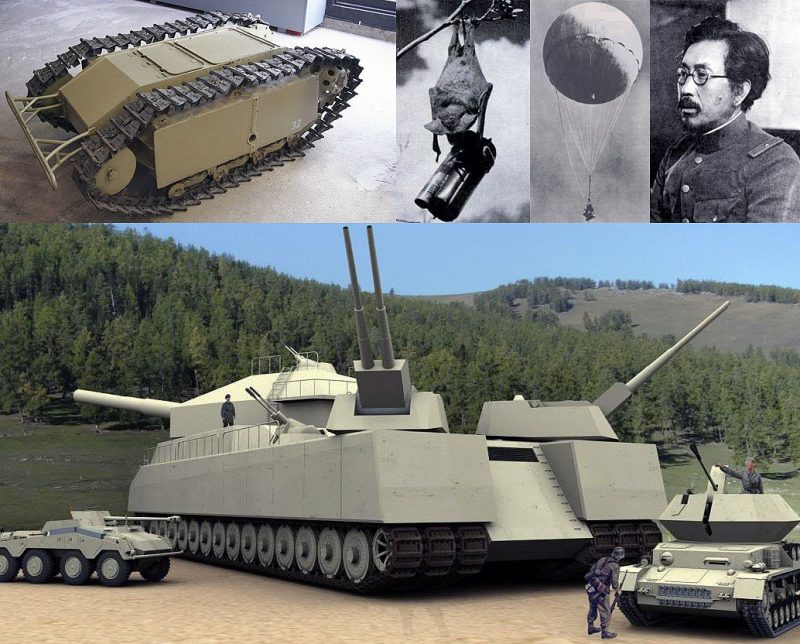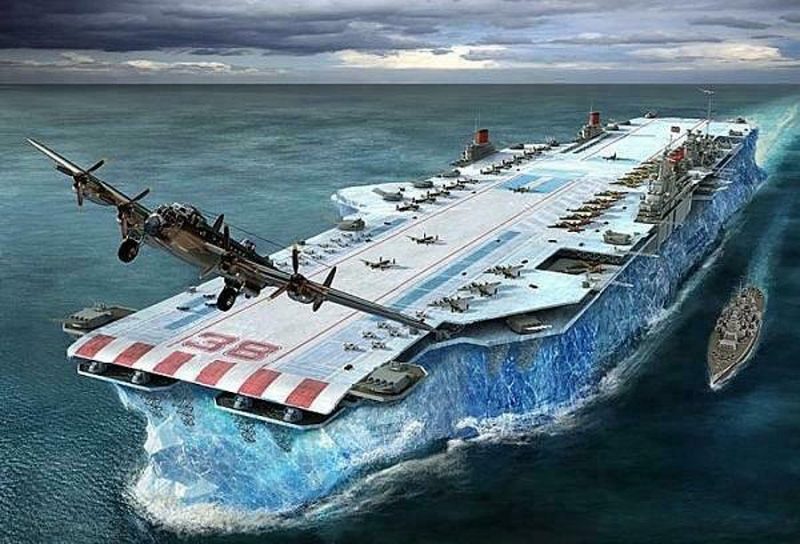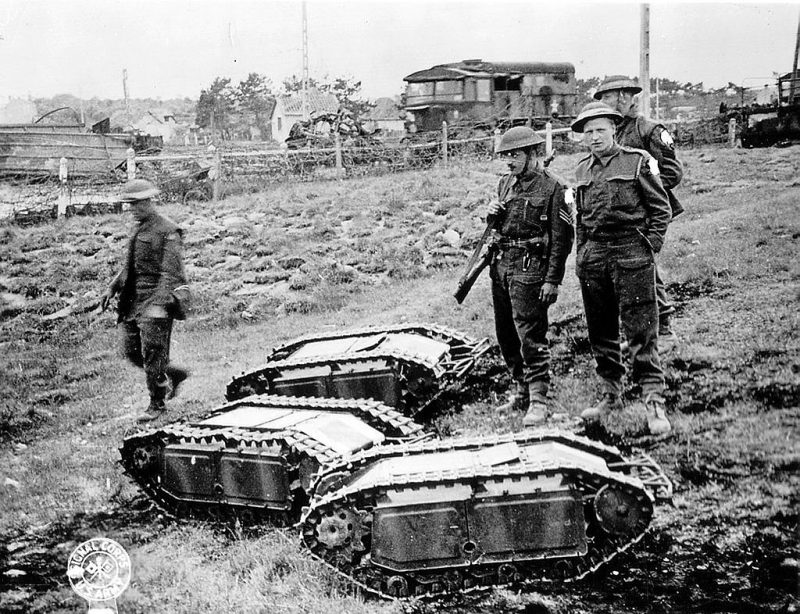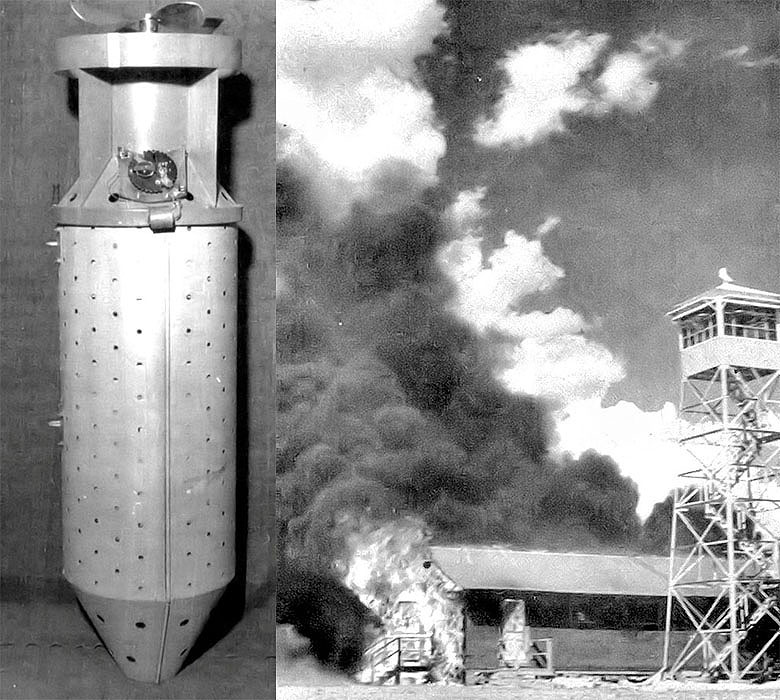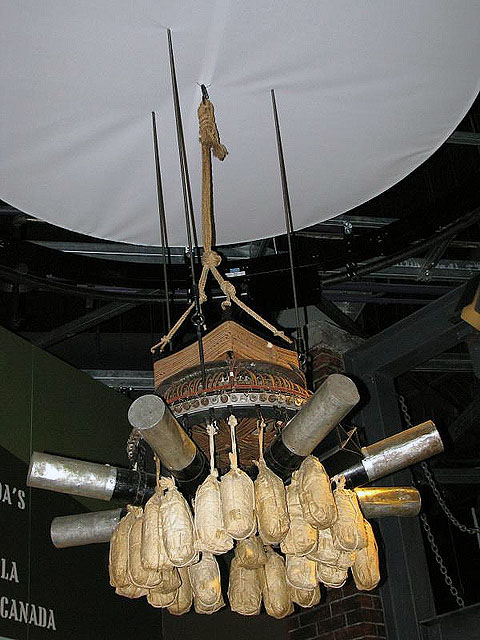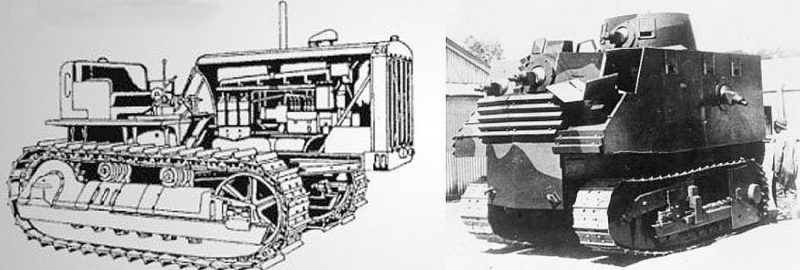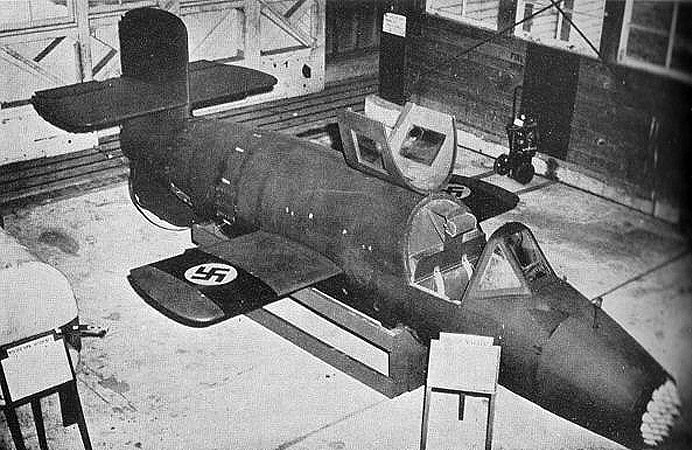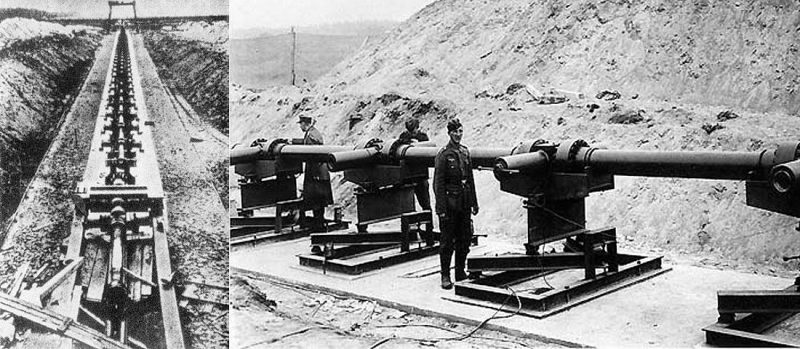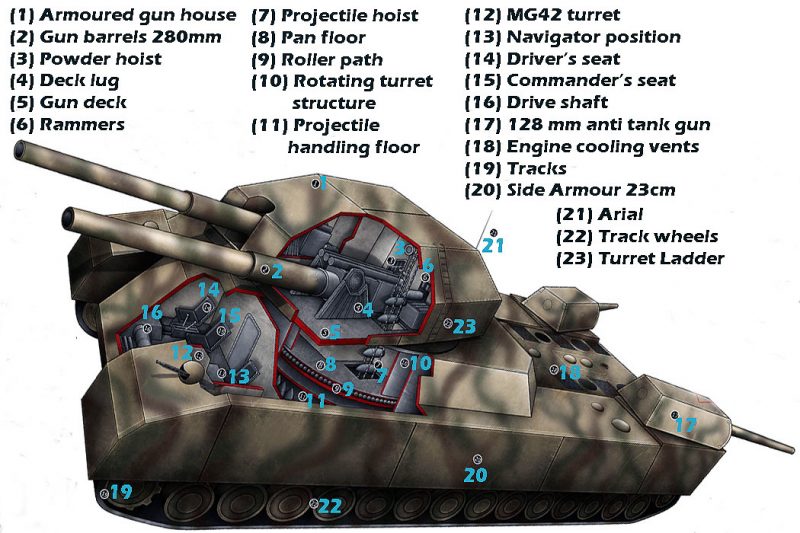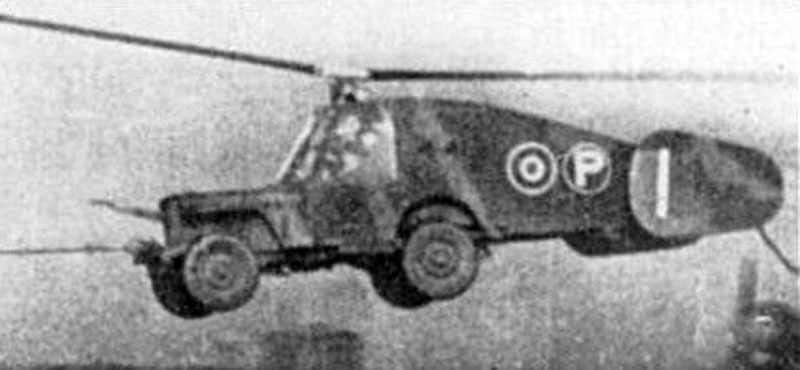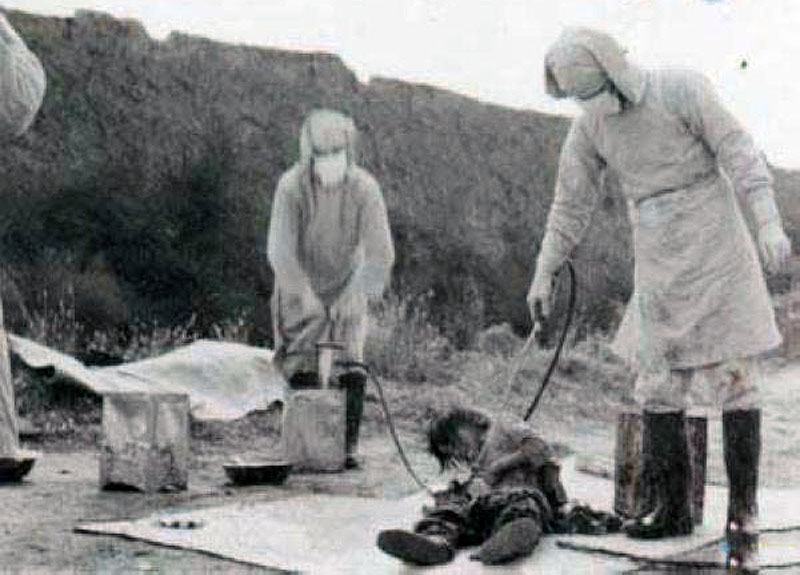Images used (Clockwise from top left): (1) A WWII SdKfz. 302 model of Goliath Tracked Mine, displayed at the Tank Museum in Munster, Germany in 2005 (2) A bat with incendiary bomb attached during WWII, bats can carry a lot more than their own weight during flight (3) A Japanese Fu-Go or fire balloon, shot-down and then re-inflated by Americans in California (4) Major General Shirō Ishii, who was director of Unit 731, infamous Japanese biological warfare unit during WWII (5) Comparative size of 1942 Landkreuzer P. 1000 Ratte, Experimantal Super Tank Design
There is a common saying that necessity is the mother of all invention. And a country’s necessity is the greatest amidst war-time. During the Second World War, the world witnessed for the first time hundreds of cutting-edge and sometimes bizarre war machines. Some of these weapons were made and became quite popular; some were produced up to prototype level and some crazy conceptual weapons were abandoned during designing and planning stage.
(1) Ice Aircraft Carrier “Bergships” Under Project Habakkuk (1942 to 1943):
British unorthodox inventor Geoffrey Pyke is known for coining an idea of a material called pykrete and proposing to construct the ship Habakkuk from it during the WWII. Pyke’s one earlier innovative design was converted into the US made tracked vehicle called M29 Weasel used for winter operations in Romania, Norway and the Italian Alps.
Image used: Illustrated image of a WWII Bergship under Project Habakkuk
During that period of war, the Allies were losing a large number of warships and supply ships to German submarines known as U-boats in the Atlantic. Aircrafts were very efficient at destroying surfaced U-boats. But the Aircrafts did not have adequate range to cover the entire Atlantic. If a Aircraft landing platform could be built in the middle of the ocean, then the U-boats could be put under serious pressure. Moreover, there was a shortage of aluminum and steel. Pyke took the challenge to solve this problem and realized the ice was the answer as ice takes only 1% of energy needed to make an equal amount of steel.
The project’s name was taken from the Bible. Even the project’s goal was a quote from it: “… be utterly amazed, for I am going to do something in your days that you would not believe, even if you were told.” -Bible (NIV), Habakkuk 1:5
But ice proved unsuitable as natural icebergs have very small surface above water for aircrafts to land, are prone to roll over and splits easily. Pyke then proposed a frozen composite called Pykrete, made of 14% sawdust or wood pulp and 86% water. It melted slower than ice, had the strength and toughness as good as that of concrete. A small prototype of the Habakkuk Bergship was constructed at Patricia Lake in Alberta, Canada. It was 60 feet (18 m) by 30 feet (9m), weighing 1,000 tons and a one-horsepower motor was used to keep it frozen. The final design was required to be 2000 feet (610m) long with a 40 feet (12m) thick hull to withstand any torpedo attack. An extensive cooling system was to be used to prevent the melting of the pykrete. It was supposed to have a displacement of 2.2 million tons carrying 150 aircrafts. In December 1943, in the last meeting of the project, it was officially concluded that Habakkuk II had been found to be impractical due to huge cost in the range of $100 million was involved. Also Portugal agreed to allow its port to be used for U-boat hunting and number of escort carriers was increased by 1944.
(2) ‘Goliath Tracked Mine’, the Remote Controlled Demolition Carrier (1942 to 1945):
It was a German-engineered explosive carrier demolition vehicle and is also known as ‘beetle tank’. The allies dubbed it ‘doodlebugs’. 7,564 of these devices were produced by the Germans. It was capable of carrying 60-100 kg (132-220 lb) of explosives to targets, which were typically tanks, dense infantry, bridges and buildings. Goliaths were considered unsuccessful due low speed of just 6 mph or 9.7 kmph, vulnerable command cables, high unit cost and thin 10mm armor that was easily pierced by any type of anti tank device causing detonation of the explosives inside. However, Goliath was a pioneer in advancement of post war technologies related to remote-controlled vehicles.
Image used: British soldiers during WWII with captured German Goliath tracked mines
(3) Bat Bombs, an American Experimental Weapon (January 1942):
After the Imperial Japanese Navy attacked on US naval base at Pearl Harbor on December 7, 1941, United States entered the WWII. Among different measures against Japanese aggression was a ‘Bat Bomb’ plan proposed in January 1942 by Lytle Adams, a dentist in Pennsylvania and a friend of First Lady Eleanor Roosevelt. Adams’ observation was the infrastructure of Japan was mostly made of bamboo, paper etc and was quite susceptible to fire. The plan was to create a bomb shaped casing with many compartments each containing a small timed incendiary bomb attached to a Mexican Free-tailed Bat.
The 123 cm (48 in) long 123 kg (271 lb) bat bombs were scheduled to be dropped at dawn from a bomber over Japanese airspace. The Bat Bomb casing would deploy a parachute in mid air around 1000ft and open compartments to release the bats which would roost in attics and eaves to stay away from daylight. Shortly, the time delayed fire bombs would detonate, sparking devastating and raging fire throughout Japanese cities. The project was approved by President Roosevelt.
Images used (from left): (1) The bat bomb canister developed in 1942 (2) Accidental burning down of Carlsbad Air Base facilities in New Mexico while testing bat bombs in 1943
During one test drop in 1943, some accidental release of the armed bats set an Army Airfield’s Auxiliary Air Base in New Mexico on fire and burned some testing facilities to ground. This proves that the Bat Bombs worked. Further tests were scheduled to be conducted in 1944. $2 million had been spent on the bat bomb project. But to end the Japanese war quickly, atomic bomb project was prioritized and the Bat Bomb project was cancelled, luckily for the thousands of bats.
(4) Fu-Go or Fire Balloon, a Windship Weapon (1944 to 1945):
More than 9,300 of these hydrogen balloons, each containing either a 12 kg (26 lb) incendiary bomb or a 15kg (33 lb) antipersonnel bomb along with four 5 kg (11 lb) incendiary apparatus were launched by the Japanese. Though there were high hopes of their Japanese designers, only 300 of these were observed or found reaching the United States causing only a small amount of damage to US facilities and 6 deaths.
Image used: A Japanese Fu-Go or fire balloon with incendiary apparatus attached
These were comparatively cheaper weapons which were designed to use the Tropospheric jet stream over the Pacific Ocean and hit targets in United States. It had some psychological effect on the American people and triggered some panic. Due to little outcome of the money invested, the Japanese military leaders abandoned the project in April 1945. Inspired by the Japanese Fu-Go, American E77 Balloon Bombs were developed in 1950 and tested with biological munitions by US Army’s Chemical Corps.
(5) Bob Semple Tank, a Bit More Than a Farm Tractor (1944 to 1945):
During WWII, Australia and New Zealand found themselves in a delicate situation. Being technically part of the British Empire, both the nations were at war with the Axis forces, especially Japan. But these regions were so far away from England that the British couldn’t afford to send tanks there. There weren’t any armored fighting vehicle industry in New Zealand or in Australia as such requirement was expected to be full-filled by the UK. But loss of most British tanks in France in mid 1940 during the Fall of France complicated situation for Britain, let alone sending armored structures to its colonies.
With the Japanese advancing rapidly and conquering one island after another in the Pacific, New Zealand decided to build its own tanks. The country’s Minister of Work Bob Semple came up with the plan of building tanks with using tractor base and corrugated iron. It was without any blueprints or formal plans. The design somewhat followed the American Disston Six Ton Tractor Tank. The 25.4 ton Bob Semple Tank had a length of 4.2 m (13 ft 9 in), width of 3.3 m (10 ft 10 in) and was 3.65m (12ft) tall. It could carry 8 combatants, had an armor of just 20mm and a speed of 24 kmph. It did not have conventional armor plating rather corrugated manganese plating hardly good enough to deflect bullets.
The first prototype was built over the base of a Caterpillar D8 tractor and was fitted with 7 Bren Light Machine Guns. Due to functional failures, tractor gear problems, public ridicule and impracticality, the Bob Semple Tanks were rejected to be included into New Zealand Army and was restored back to tractors.
Image used: One of the prototypes of the tractor-turned-Bob Semple Tank
(6) Bachem Ba 349 German Interceptor (1945):
This point-defence German interceptor was powered by rocket and was first used on 1st March 1945. The air superiority of Luftwaffe over Axis occupied land were challenged by the Allies in 1943. To counter the Allied strategic bombing, surface to air missile (SAM) type weapons became more effective. Bachem Ba 349 was similar to a SAM designed by German Engineer Erich Bachem.
Image used: A captured Ba 349 on display at Freeman Field in Indiana, United States in September 1945
It required no runway as it took-off from a vertical 8m (25 ft) rail fixed with a small tower. Most of the work in this interceptor aircraft was done by autopilot. A relatively inexperienced pilot inside it had one major work of aiming the Interceptor at its target bomber plane and firing rockets. After firing off all the rockets and upon running out of fuel, the Ba 329 would glide down to 3,000m (10,000ft). The nose would be jettisoned off. Then the pilot and the fuselage containing the motor of the rockets would land using two different parachutes. The first manned test flight was a disaster. At 1,500 m, 3G acceleration made the test pilot pull the aircraft controller wrongly causing a nose dive crash. 36 of Bachem Ba 349 were built by the end of the WWII but were never deployed in active warfare.
(7) V-3 Cannon, the London Gun (1944 to 1945):
The ‘V-3 cannon’ was a German WWII Supergun working on the principle of multi-charge along the barrel’s length where to add the velocity of a projectile, secondary propellant charges are fired as soon as the projectile passed them. V stands for Vergeltungswaffe which means retaliatory weapons. Germans used to call it HDP (Hochdruckpumpe) gun that meant High Pressure Pump.
In retaliation to the German cities pounded to rubble by the Allied bombers, this supergun was developed as ‘vengeance’ weapon by the Germans. A 130m (430 ft) long V-3 Cannon with 165km range was almost fully constructed at bunkers at Pas-de-Calais region in Northern France. The shells inside the cannon had the ability to achieve a muzzle velocity of 1,500m/s (4,900 ft/s) and fire 300 shells per hour. Weight of each shell was 140kg (310 lb). It was planned to be used to strike back at London by October 1, 1944 but was disable by Allied bombing raid before completion of construction. The Allied forces used the deep-penetrating Tallboy bombs, each of which was 5,400kg (11,900 lb).
Images used (from left): (1) A V-3 cannon or London Gun during WWII (2) American Soldiers analyzing a captured V-3 at Pas-de-Calais, Northern France.
However, two more V-3 Cannons with shorter barrels of 50m (160ft) were constructed at Trier city in Germany in late 1944. These were used against Luxemburg which was 43km (27mi) away from the V-3 cannons and had been liberated in September 1944. Muzzle velocity of this shortened barrel V-3 cannons was 935m/s (3,070 ft/s).
The first gun was ready by December 30, 1944 but only 7 shells were fired with it. The second gun tube was operational by January 11, 1945 and till February 22, 1945, it fired some 183 rounds, 44 of which hitting the urban targets. 142 of the fired shells struck Luxembourg. 10 people were dead and 35 wounded. Due to such small number of casualties, the V-3 cannons were not considered as very effective. On February 22, 1943, when American soldiers advanced within 3 kilometers of the cannon site, all was quiet on the western front.
(8) Landkreuzer P. 1000 Ratte, Experimantal Super Tank Design (1942 to 1943):
German weapon manufacturing company Friedrich Krupp AG designed this super heavy tank in 1942 upon approval of Adolf Hitler. But German Minister of Armaments and War Production, Albert Speer cancelled the project in 1943 before any units were constructed. At 1000 metric tons, if built, it would have been 5 times heavier than the heaviest tank ever built, Panzer VIII Maus.
Image used: Size comparison between German tanks- Landkreuzer P. 1000 Ratte, Panzer VIII Maus and Tiger II tanks
It was designed to be armed with naval artillery with 25 cm (10in) hardened stell armor. To compensate for the Ratte’s immense weight, it would have been fitted with three 1.2 m (3ft 11in) wide caterpillar track or treads on each side with a total 7.2m (24ft) tread width. Main weapon of the Super Tank would have been two 280 mm SK C/24 Naval guns. A 128 mm anti tank gun, eight 20 mm Flak 38 anti aircraft guns and two 15mm MG151 auto-cannons were also part of the armaments of the Ratte. Two 6,300 KW (8,400 hp) marine diesel engines of U-boats or eight 1,500KW (2,000hp) E-boat engines were supposed to be fitted with the super tank. It was supposed to carry up to 41 crews and attain maximum speed of 40kmph (25mph).
Image used: Cutaway illustration depicting the Landkreuzer P. 1000 Ratte Super Tank Design. There were no blueprints of interior of this tank; assumptions were made based on similar German battleships.
(9) Hafner Rotabuggy, British Experimantal ‘Flying Jeep’ (1943 to 1944):
It was basically a rotor kite fitted Willys MB, the US Army Jeep, intended to introduce air-dropping ability of the off-road vehicles. Raoul Hafner, an Austrian born British helicopter engineer of the Airborne Forces Experimental Establishment, designed this aircraft and a prototype was built in 1942. It required two personnel to pilot it, one to pilot it in the air and another to drive it as an automobile. Its name was changed from ‘Blitz Buggy’ to ‘Rotabuggy’.
Image used: British experimental aircraft, Hafner Rotabuggy in flight in 1943
It could be dropped from heights up to 2.35m (7.7ft) without any damage. The diameter of the rotor was 12.4m (40ft 8.2in). The buggy had tail fins and fairing but no rudders. Several test flights were carried out between 16 November 1943 and February 1, 1944. If dropped from an aircraft, it could fly at 65mph (105kmph) and maintain altitude of around 400ft (121.9m). It could also takeoff from the ground if towed behind a 4.5 liter Bentley Supercharger automobile or an Armstrong Whitworth A.W.38 Whitley, the British bomber. Rotabuggy’s last test flight was also described as ‘highly satisfactory’. However, vehicle carrying gliders such as Airspeed Horsa and Waco Hadrian made the Rotabuggy redundant and the ‘Flying Jeep’ project was subsequently cancelled.
(10) Flea Bombs, the Covert Japanese Biological & Chemical Warfare during WWII (1940 to 1941):
The Japanese Unit 731 was a covert Chemical and Biological warfare research & development unit that operated between 1935 and 1945 participating in the Second Sino Japanese War (1937-1945) and WWII. Some of the most heinous war crimes were carried out by the Japanese combatants of this unit including germs warfare attacks on Chinese People in the form of Flea Bombs.
Laboratory bred bubonic plague fleas, infected supplies and infected clothing encased in bombs were dropped by low-flying aircrafts upon various targets in Chinese cities. Plague fleas were also sprayed upon coastal city Ningbo in 1940, Changde city in Hunan Province in 1941. Thousands of people were killed in this manner by triggering bubonic plague epidemics.
An International Symposium on Crimes of Bacteriological Warfare in Changde, China in 2002 estimated that at least 580,000 Chinese people died due to the WWII biological attacks by Japan. Another historian puts the figure at 200,000. 1,700 Japanese in Chekiang, China were also killed by the very germ weapons they triggered. During the last months of WWII, Japan had a schedule on September 22, 1945, to use plague bombs against San Diego, California. But Hirohito was forced to surrender five weeks earlier.
Soviet Union prosecuted twelve top scientists and military leaders from Unit 731 during Khabarovsk War Crime Trials in 1949 and Major General Kiyoshi Kawashima and other accused testified that some 40 members of Unit 731 dropped flea bombs in 1941. They were found guilty and were sentenced between two years to twenty five years in a Siberian labor camp. United States did not acknowledge this trial and Soviet Union built a biological weapon facility in Sverdlovsk (now Yekaterinburg) using the blueprints captured from Unit 731 in Manchuria.
Image used: An unidentified Chinese victim of Japanese Unit 731’s human experimentation.
